Cost-effectiveness of a personal health document in different distribution settings
Abstract
Issue addressed
The aim was to compare the cost-effectiveness of different ways to distribute a personal health document that was primarily aimed at supporting behaviour change. Personal health documents have been widely used in health-promoting efforts but their effective use is rather sparsely studied.
Methods
Four types of distribution were tested in Sweden: primary health care centres (n=418); work site meetings (n=164); at an occupational health examination (n=279); by mail (n=445). Participant behaviour changes were measured by a questionnaire. Cost calculations were made based on the results of the study.
Results
Between 10% and 26% of participants reported behaviour changes as a result of reading the booklet. A change in health situation was less likely using postal distribution. There were no significant differences between the other types of distribution. Cost-effective distribution at work sites and in occupational health was superior to distribution in primary health care when direct costs were used. Distribution at work sites was the least cost-effective when indirect costs, i.e. productivity losses of participants, were included.
Conclusions
Cost-effectiveness analyses support distribution of personal health documents in occupational health. In primary health care, high training costs in combination with low distribution rates might be problematic. Providing information during distribution at work sites is time-consuming and might therefore be a problem if productivity losses are taken into account.
So what?
Personal health documents are relevant to health behaviour change, and several distribution methods are available.




